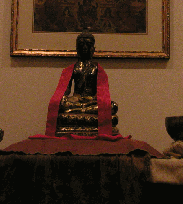|
Biography
The Venerable Lama Losang Samten, a renowned Tibetan scholar and teacher, and a former Buddhist monk, was born in Chung Ribuce, of central Tibet. In 1959, he and his family fled to Nepal, Solukhumbu and later moved to Dharamsala, India in 1963 where he met His Holiness the 14th Dalai Lama for the first time. During this time, Samten attended a Tibetan refugee public school. Later in 1965, at the age of 12, he chose to become a Buddhist monk while attending the refugee public school in Kalimpong, West Bengal. From 1966 - 1968, Samten studied traditional folk dance and music, and acting at the Tibetan Institute of Performing Arts in Dharamsala. In 1969, he joined the Namgyal Monastery, the monastery of His Holiness the Dalai Lama where, in 1985, he earned a Master's Degree in Buddhist Philosophy, Sutra, Tantra, and art which is equivalent to a Ph.D. From 1983 - 1993, Samten served as the personal attendant to His Holiness the 14th Dalai Lama. In 1994, he returned his monastic vows to his root teacher. In the same year, he received an Honorary Doctorate of Divinity from Trinity College in Hartford, Connecticut. He was granted an Honorary Doctorate of Art from the Maine College of Art in 1995. Samten taught Tibetan language at the University of Pennsylvania in Philadelphia from 1994 - 1997. He was awarded the National Heritage Fellowship from the National Endowment for the Arts in 2002. In 2004, he was awarded a Pew Fellowship in the Arts.
In 1988, Samten came to the US as instructed by His Holiness the 14th Dalai Lama and the Namgyal Monastery to demonstrate the meditative art of sand painting. This was the first time a Tibetan mandala was shown in the west for the general public. Since then, he has created sand mandalas at the American Museum of Natural History in New York City, Chicago Field Museum, Philadelphia Museum of Art, Museum of Archaeology and Anthropology of University of Pennsylvania, Asian Art Museum in San Francisco, the Smithsonian Institute in Washington DC, and among other museums in the world. He has also created mandalas and gave lectures at universities such as the Harvard University, Columbia University, New York University, Trinity College of Hartford, Connecticut, Massachusetts Institute of Technology (MIT), Georgetown University, and numerous other universities, museums, and public/private schools (see list below). Samten's work received local, national, and international media coverages, such as in the Time Magazine, New York Times, Washington Post, Chicago Tribune, Philadelphia Inquirer, Miami Herald, San Francisco Chronicle, CNN, ABC, NBC, CBS, PBS, Public Radio and among others. Samten has served as the religious technical advisor and sand mandala supervisor as well as actor for Martin Scorsese's film Kundun and for the TV series, Madam Secretary, Episode 'Swept Away' in 2017.
Losang Samten is the founder of the Tibetan Buddhist Center of Philadelphia, the Chenrezig Tibetan Buddhist Center of Middletown, Connecticut, and the Chenrezig Buddhist Cultural Center of El Paso, Texas and currently he is the spiritual director for the centers in Philadelphia and in El Paso. He travels extensively all over the United States and Canada sharing his knowledge of Buddhist philosophy, meditation, Tibetan ritual art and cultures and also leads retreats. Samten also shares his knowledge abroad in countries such as Brazil, Argentina, Chile, Mexico, and Denmark. He has participated in festivals such as the Smithsonian Folklife Festival 2023, Sacred Arts Festival at Glencairn Museum, and International Art Festival in Prague.
Losang wrote three books: History of the Namgyal Monastery, History of the 14th Dalai Lama's Summer Residence in Leh Ladakh, India, and Ancient Teachings in Modern Times. He has also produced and directed a documentary on the History of Buddhist Ritual Dance (Tse Gutor).
As volunteers, Samten and his partner, Soo Kyong Kim make visits to the correctional facilities in New York, Philadelphia, Nevada, New Mexico, and Canada to lead meditation for the inmates. They also have frequent correspondences with them by mail.
Losang and Soo Kyong lead numerous pilgrimages to holy sites in India, Nepal, and Ladakh. They also love and enjoy taking care of street dogs in Dharamsala and Ladakh.
|
|

